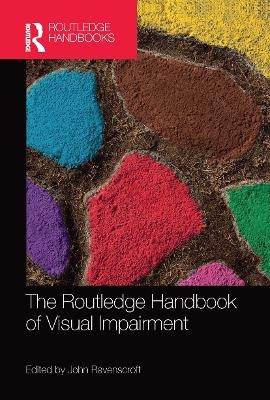
The Routledge Handbook of Visual Impairment
Routledge (Verlag)
978-0-367-67059-7 (ISBN)
It is the intention of this Handbook to provide an opportunity to engage with academic researchers who wish to ensure a coherent and rigorous approach to research construction and reflection on visual impairment that is in collaboration with, but sometimes is beyond, the medical realm.
This Handbook is divided into ten thematic areas in order to represent the wide range of debates and concepts within visual impairment. The ten themes include:
cerebral visual impairment;
education;
sport and physical exercise;
assistive technology;
understanding the cultural aesthetics;
socio-emotional and sexual aspects of visual impairment;
orientation, mobility, habitation, and rehabilitation;
recent advances in "eye" research and sensory substitution devices;
ageing and adulthood.
The 27 chapters that explore the social and cultural aspects of visual impairment can be taken and used in a variety of different ways in order to promote research and generate debate among practitioners and scholars who wish to use this resource to inform their practice in supporting and developing positive outcomes for all.
John Ravenscroft, PhD (Chair of Childhood Visual Impairment) is a psychologist, educationalist and lectures a little in philosophy. He has vast experience of inclusive education, and has advised various governments, locally, nationally and internationally on promoting inclusive education. Professor Ravenscroft is also Head of the Scottish Sensory Centre, which is a national centre that provides career-long professional development for teachers of children with sensory impairment, including those with cerebral visual impairment. He is also the current editor-in-chief of the British Journal of Visual Impairment and lectures on inclusive education, visual impairment, as well as on areas of virtue epistemology and ontology. He has published widely on visual impairment, disability and on research methods.
List of figures; List of tables; List of contributors; Acknowledgements; List of abbreviations; Section I: Introducing and understanding the profile, sociological and psychological impact of Visual Impairment.; Chapter 1. Introduction and Synthesis of Themes: The Editor’s Perspective. (John Ravenscroft); Chapter 2. Global Data on Vision Loss: Implications for Services. (Jill Keeffe); Chapter 3. Psychological Representation of Visual Impairment: Perception and How Visually Impaired People "See" the World. (Jennifer C. Fielder & Michael J. Proulx); Chapter 4. On being blind. (Gaylen Kapperman); Section II: Cerebral Visual Impairment / Cerebral Visual Processing.; Chapter 5. Cerebral (Cortical) Visual Impairment in Children – A Perspective. (Gordon N Dutton & Corinna M Bauer); Chapter 6. A Personal Perspective on CVI. (Nicola McDowell); Chapter 7. Assessment of Visual Processing Functions and Disorders. (Lea Hyvärinen); Section III: Education.; Chapter 8. Trends in Low Vision Education: Learning from the Past, Looking to the Future.; (Amanda Hall Lueck & Gregory L. Goodrich); Chapter 9. Formal and non-formal education for individuals with vision impairment or multiple disabilities and vision impairment: Current trends and challenges. (Vassilios Argyropoulos & Frances Gentle); Chapter 10. Transition from school to Higher Education: Research evidence and best practice. (Graeme Douglas, Rachel Hewett & Mike McLinden); Chapter 11. Career Education for Students with Visual Impairments. (Karen E. Wolffe); Section IV: Sport and Physical Exercise for People with Visual Impairment.; Chapter 12. Teaching Children who are Deafblind in Physical Education, Physical Activity and Recreation. (Lauren J. Lieberman & Justin A. Haegele); Chapter 13. Movement and Visual Impairment: Research and Practice. (Justin A. Haegele & Lauren J. Lieberman); Section V: Assistive technology.; Chapter 14. Assistive Technology Foundations in Research. (Yue-Ting SIU); Section VI: Understanding the Cultural Aesthetics.; Chapter 15. Classic Philosophies on Blindness and Cross-Modal Transfer. (Simon Hayhoe); Chapter 16. In Vision and Touch, Pictures Trigger Equations for Surfaces and Edges. (John M. Kennedy); Chapter 17. Art, Visual Impairment and the Gatekeepers of Aesthetic Value. (David Feeney); Chapter 18. Using Expressive Movement and Haptics to Explore Kinaesthetic Empathy, Aesthetic and Physical literacy. (Wendy Timmons & John Ravenscroft); Section VII: Socio-Emotional and Sexual Aspects of Visual Impairment.; Chapter 19. Socio-emotional Aspects of Visual Impairment: A practitioner’s perspective. (Joao Roe); Chapter 20. Self Esteem of People with Visual Impairment. (Samir Qasim); Chapter 21. Human Mate Selection Theory: Specific Considerations for Persons with Visual Impairments. (Gaylen Kapperman & Stacy M. Kelly); Section VIII: Orientation, Mobility, Habilitation, and Rehabilitation.; Chapter 22. Modern Approaches to Orientation and Mobility: Habilitation and Rehabilitation. (Karl Wall); Chapter 23. Measuring vision, orientation and mobility in the wild. (Lil Deverell); Section IX: Recent Advances in ‘Eye’ Research and Sensory Substitution Devices.; Chapter 24. An overview of human pluripotent stem cell applications for the understanding and treatment of blindness. (Louise A. Rooney, Duncan E. Crombie, Grace E. Lidgerwood, Maciej Daniszewski, & Aice Pébay); Chapter 25. Technologies for Vision Impairment: Bionic Eyes and Sensory Substitution Devices. (Lauren N. Ayton, Penelope J. Allen, Carla J. Abbott, & Matthew A. Petoe); Section X: Aging and Adulthood; Chapter 26. Employment and Visual Impairment: Issues in Adulthood. (Natalie Martiniello & Walter Wittich); Chapter 27. Aging and Combined Vision and Hearing Loss. (Walter Wittich & Peter Simcock); Index
| Erscheinungsdatum | 16.01.2021 |
|---|---|
| Reihe/Serie | Routledge International Handbooks |
| Verlagsort | London |
| Sprache | englisch |
| Maße | 174 x 246 mm |
| Gewicht | 453 g |
| Themenwelt | Sachbuch/Ratgeber ► Gesundheit / Leben / Psychologie ► Lebenshilfe / Lebensführung |
| Medizin / Pharmazie ► Gesundheitsfachberufe ► Hebamme / Entbindungspfleger | |
| Studium ► 1. Studienabschnitt (Vorklinik) ► Med. Psychologie / Soziologie | |
| Studium ► Querschnittsbereiche ► Prävention / Gesundheitsförderung | |
| Sozialwissenschaften ► Pädagogik ► Sozialpädagogik | |
| Sozialwissenschaften ► Soziologie | |
| ISBN-10 | 0-367-67059-3 / 0367670593 |
| ISBN-13 | 978-0-367-67059-7 / 9780367670597 |
| Zustand | Neuware |
| Haben Sie eine Frage zum Produkt? |
aus dem Bereich


